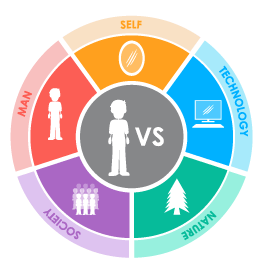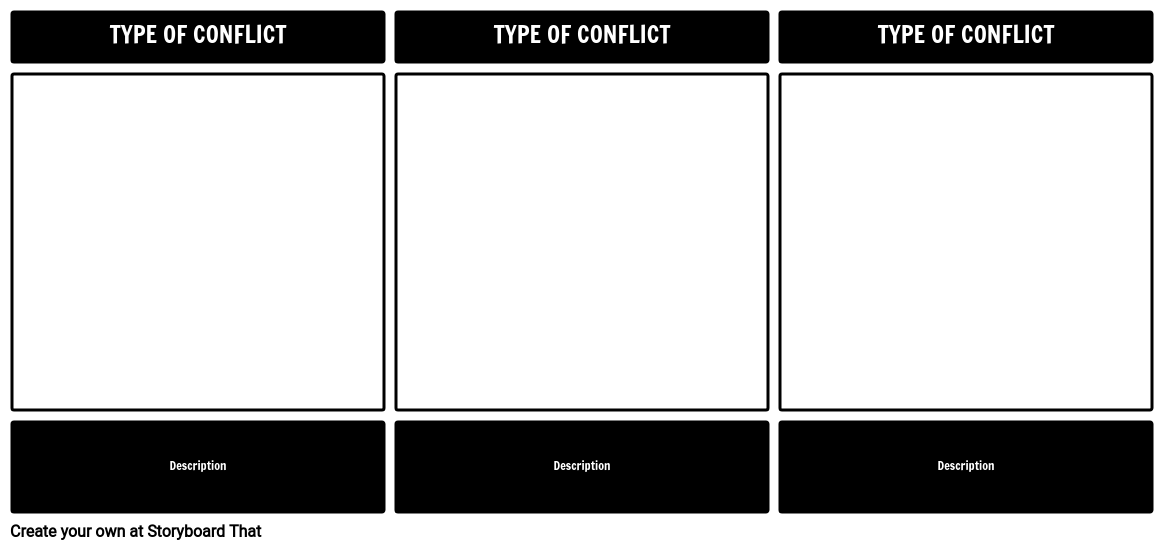Lesson Plan Overview
Literary conflicts are often taught during ELA units. An excellent way to focus on the various types of literary conflict is through storyboarding. Having students choose an example of each Literary conflict and depict it using storyboards is a great way to reinforce your lesson.
Anne Frank: The Diary of a Young Girl is rife with conflict. There are many interpersonal conflicts between the characters, as well as larger societal conflicts. The Franks are driven into hiding because of the anti-Jewish policies of the Nazi regime, and on a smaller scale, Anne gets annoyed and hurt by the adults who criticize her.
Have students choose one, or a few, of the conflicts in Anne Frank: The Diary of a Young Girl. Using a T-Chart or a traditional storyboard, students can identify various examples of conflicts and depict them with explanations. In the prototype example below, each cell contains a particular type of conflict. The type of conflict is displayed, and visually represented with an explanation of the scene, and how it fits the specific category of conflict.
Examples of Literary Conflict in Anne Frank
MAN vs. MAN
Mrs. Van Daan and Mr. Van Daan regularly get into arguments, sometimes over very trivial matters. The limited space in the Secret Annexe means the rest of the occupants are also affected.
MAN vs. SELF
Anne struggles with the isolation and boredom of the seclusion in the Secret Annexe and with fear of being caught. She writes letters to her friend, "Kitty", that are really diary entries.
MAN vs. SOCIETY
Leading up to and during World War II, Nazi Germany persecuted and eventually imprisoned Jews in concentration camps. Millions of Jews died there.
Template and Class Instructions
(These instructions are completely customizable. After clicking "Copy Activity", update the instructions on the Edit Tab of the assignment.)
Student Instructions
Create a storyboard that shows at least three forms of conflict in the Diary of Anne Frank.
- Identify conflicts in the Diary of Anne Frank.
- Categorize each conflict as Character vs. Character, Character vs. Self, Character vs. Society, Character vs. Nature, or Character vs. Technology.
- Illustrate conflicts in the cells, using characters from the story.
- Write a short description of the conflict below the cell.
Lesson Plan Reference
Student Rubric
(You can also create your own on Quick Rubric.)
| Proficient | Emerging | Beginning | |
|---|---|---|---|
| Conflict Identification | Student identifies conflicts as directed and labels them accurately in their correct categories. | Student misidentifies one conflict or includes it in an incorrect category. | Student misidentifies two or more conflicts or includes them in incorrect categories. |
| Conflict Explanation | The storyboard text describes the specific example depicted, not just a general problem. The text clearly explains how the example reflects its particular type of conflict. | The storyboard text describes the specific example depicted, but may lack clarity. Text may fail to fully explain how the example reflects its particular type of conflict. | Storyboard is missing text or contains only partial and/or inaccurate information. |
| Storyboard Image and Effort | Student clearly shows effort to convey the setting, characters and specific scene of the book. The scene is clearly identifiable based on the graphic depiction. | Student attempts to convey the setting, characters, and specific scene through use of graphics, but the depiction may be confusing, disordered, or lack some detail. | Student does not clearly convey the setting, characters, and scene. |
| Spelling and Grammar | Student uses exemplary spelling and grammar. There are no errors. | Student makes one or two minor errors in spelling and grammar. | Student makes multiple errors in spelling and grammar. |
Lesson Plan Overview
Literary conflicts are often taught during ELA units. An excellent way to focus on the various types of literary conflict is through storyboarding. Having students choose an example of each Literary conflict and depict it using storyboards is a great way to reinforce your lesson.
Anne Frank: The Diary of a Young Girl is rife with conflict. There are many interpersonal conflicts between the characters, as well as larger societal conflicts. The Franks are driven into hiding because of the anti-Jewish policies of the Nazi regime, and on a smaller scale, Anne gets annoyed and hurt by the adults who criticize her.
Have students choose one, or a few, of the conflicts in Anne Frank: The Diary of a Young Girl. Using a T-Chart or a traditional storyboard, students can identify various examples of conflicts and depict them with explanations. In the prototype example below, each cell contains a particular type of conflict. The type of conflict is displayed, and visually represented with an explanation of the scene, and how it fits the specific category of conflict.
Examples of Literary Conflict in Anne Frank
MAN vs. MAN
Mrs. Van Daan and Mr. Van Daan regularly get into arguments, sometimes over very trivial matters. The limited space in the Secret Annexe means the rest of the occupants are also affected.
MAN vs. SELF
Anne struggles with the isolation and boredom of the seclusion in the Secret Annexe and with fear of being caught. She writes letters to her friend, "Kitty", that are really diary entries.
MAN vs. SOCIETY
Leading up to and during World War II, Nazi Germany persecuted and eventually imprisoned Jews in concentration camps. Millions of Jews died there.
Template and Class Instructions
(These instructions are completely customizable. After clicking "Copy Activity", update the instructions on the Edit Tab of the assignment.)
Student Instructions
Create a storyboard that shows at least three forms of conflict in the Diary of Anne Frank.
- Identify conflicts in the Diary of Anne Frank.
- Categorize each conflict as Character vs. Character, Character vs. Self, Character vs. Society, Character vs. Nature, or Character vs. Technology.
- Illustrate conflicts in the cells, using characters from the story.
- Write a short description of the conflict below the cell.
Lesson Plan Reference
Student Rubric
(You can also create your own on Quick Rubric.)
| Proficient | Emerging | Beginning | |
|---|---|---|---|
| Conflict Identification | Student identifies conflicts as directed and labels them accurately in their correct categories. | Student misidentifies one conflict or includes it in an incorrect category. | Student misidentifies two or more conflicts or includes them in incorrect categories. |
| Conflict Explanation | The storyboard text describes the specific example depicted, not just a general problem. The text clearly explains how the example reflects its particular type of conflict. | The storyboard text describes the specific example depicted, but may lack clarity. Text may fail to fully explain how the example reflects its particular type of conflict. | Storyboard is missing text or contains only partial and/or inaccurate information. |
| Storyboard Image and Effort | Student clearly shows effort to convey the setting, characters and specific scene of the book. The scene is clearly identifiable based on the graphic depiction. | Student attempts to convey the setting, characters, and specific scene through use of graphics, but the depiction may be confusing, disordered, or lack some detail. | Student does not clearly convey the setting, characters, and scene. |
| Spelling and Grammar | Student uses exemplary spelling and grammar. There are no errors. | Student makes one or two minor errors in spelling and grammar. | Student makes multiple errors in spelling and grammar. |
How Tos about Anne Frank: The Diary of a Young Girl Literary Conflict
Plan a Literary Conflict Role-Play Activity for Deeper Understanding
Engage students with an interactive role-play activity to help them experience literary conflict firsthand. Role-playing brings conflicts from Anne Frank: The Diary of a Young Girl to life, encouraging empathy and critical thinking as students act out scenarios and reflect on character motivations.
Select key conflict scenes for role-play
Choose pivotal conflict moments from the book, such as arguments between characters or Anne's internal struggles. Pick scenes that show different types of conflict to make the experience meaningful and varied for your students.
Assign roles and explain character backgrounds
Divide students into small groups and assign each a scene and character roles. Provide a brief background on each character so students understand their motivations and perspectives.
Guide students to script and rehearse their scenes
Have groups brainstorm or write simple scripts that highlight the conflict. Encourage students to use direct quotes from the diary where possible to deepen authenticity and comprehension.
Facilitate performances and group discussion
Let each group perform their scene for the class. Lead a discussion afterward about how the characters felt, what caused the conflict, and how it was—or could be—resolved, fostering empathy and analysis.
Frequently Asked Questions about Anne Frank: The Diary of a Young Girl Literary Conflict
What are the main types of conflict in Anne Frank: The Diary of a Young Girl?
Anne Frank: The Diary of a Young Girl features several forms of conflict, including Character vs. Character (Anne and Mrs. Van Daan), Character vs. Self (Anne's internal struggles), and Character vs. Society (the Frank family's persecution under Nazi rule).
How can I teach literary conflict using Anne Frank's diary?
Use storyboards or T-charts to help students identify and illustrate different types of conflict from Anne Frank’s diary. Have students choose scenes that show conflicts and explain which type each represents.
What is an example of Character vs. Self conflict in Anne Frank's diary?
An example of Character vs. Self conflict is Anne’s struggle with isolation, fear, and boredom while hiding in the Secret Annexe, which she expresses in her diary entries.
Why is literary conflict important for middle school ELA lessons?
Understanding literary conflict helps students analyze character motivations, plot development, and themes, fostering deeper reading comprehension and critical thinking skills in ELA.
What storyboard activities can help students learn about conflict in Anne Frank's diary?
Assign students to create storyboards that depict at least three types of conflict from the diary. Have them illustrate each conflict, label it, and write a brief description explaining how it fits that category.
More Storyboard That Activities
Anne Frank: The Diary of a Young Girl
- Fledermaus Kabarett und Theater, poster • MCAD Library • License Attribution (http://creativecommons.org/licenses/by/2.0/)
- Fromme's Calendar, poster • MCAD Library • License Attribution (http://creativecommons.org/licenses/by/2.0/)
- Yiddish theater poster for Molly Picon in "Muchacha Del Circo" at Teatro Excelsior • Center for Jewish History, NYC • License No known copyright restrictions (http://flickr.com/commons/usage/)
Testimonials

“By using the product, they were so excited and they learned so much...”–K-5 Librarian and Instructinal Technology Teacher

“I'm doing a Napoleon timeline and I'm having [students] determine whether or not Napoleon was a good guy or a bad guy or somewhere in between.”–History and Special Ed Teacher

“Students get to be creative with Storyboard That and there's so many visuals for them to pick from... It makes it really accessible for all students in the class.”–Third Grade Teacher
© 2026 - Clever Prototypes, LLC - All rights reserved.
StoryboardThat is a trademark of Clever Prototypes, LLC, and Registered in U.S. Patent and Trademark Office







